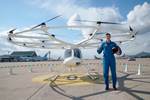Volocopter conducts first crewed flight, deploys vertiport in Italy
In addition to crewed flights in France and South Korea, the company has successfully flown the Volocopter 2X, presented Italy’s first testing vertiport and explored the VoloIQ digital platform.
Aeroporti di Roma, Volocopter (Bruchsal, Germany), UrbanV (Rome, Italy) and Atlantia (Rome) conducted a crewed electric vertical takeoff and landing (eVTOL) public test flight of Volocopter 2X in Italy the morning of Oct. 6, while presenting the country’s first advanced air mobility (AAM) testing vertiport and hosting an interactive booking process on Volocopter’s VoloIQ digital platform. The test comes one year after the eVTOL prototype was showcased in Italy, emphasizing the significant progress made in flight technology, vertiport design and the regulations necessary to enable 2024 advanced air mobility (AAM) services between Fiumicino Airport and Rome.
Volocopter 2X’s test pilot flew 40 kilometers per hour for five minutes at 40 meters height along a “figure eight” flight path in front of onlookers after attaining all the necessary clearances from the Italian authorities, the civil aviation authority Ente Nazionale per l’Aviazione Civile (ENAC) and Ente Nazionale Assistenza al Volo (ENAV), the provider of air traffic control services.
The vertiport is developed in compliance with the European Union Aviation Safety Agency’s (EASA) “Prototype Technical Specifications for the Design of VFR Vertiports for Operation with Manned VTOL-Capable Aircraft Certified in the Enhanced Category” and is located within the regulatory sandbox approved by ENAC. It is designed to host various types of tests for both flight and ground operations (turnaround, battery charging, etc.), with an electric system devised to enable testing of various eVTOL charging technologies (battery swaps, fast charging, etc.). The infrastructure, occupying an area of about 5,500 square meters, has been sized to ensure compatibility with the main eVTOLs that will be certified in the coming years and consists of a final approach and takeoff area (FATO) for landing and takeoff operations; a parking area; a covered hangar measuring 20 x 20 x 6 meters; various rooms, including an office, a warehouse and an area for battery charging.
The flight was followed by a vertiport demonstration hosted by UrbanV, a company established by ADR — together with Aéroports de la Côte d’Azur, Aeroporto di Venezia (SAVE) and Aeroporto Guglielmo Marconi di Bologna. The aim is to design and build vertiports internationally. In this context, another dimension of future AAM services was explored, the VoloIQ. From flight operations to booking and beyond, the digital platform is said to be able to support and streamline urban air mobility/advanced air mobility (UAM/AAM) operation scale-up in cities around the world to complement the physical infrastructure (vertiports) and entire ecosystem in the digital dimension.
“We’ve come from a signed partnership agreement and event series kickoff to a flight test at an operational airport in a little less than a year,” Christian Bauer, Volocopter chief commercial cfficer and interim chief financial officer (CFO), says. “With that, we are bringing together all the key stakeholders and regulators to witness this mobility service and technology with their own eyes.”
Related Content
-
Composites end markets: Automotive (2024)
Recent trends in automotive composites include new materials and developments for battery electric vehicles, hydrogen fuel cell technologies, and recycled and bio-based materials.
-
Hexagon Purus opens new U.S. facility to manufacture composite hydrogen tanks
CW attends the opening of Westminster, Maryland, site and shares the company’s history, vision and leading role in H2 storage systems.
-
Plant tour: Joby Aviation, Marina, Calif., U.S.
As the advanced air mobility market begins to take shape, market leader Joby Aviation works to industrialize composites manufacturing for its first-generation, composites-intensive, all-electric air taxi.












.jpg;maxWidth=300;quality=90)



